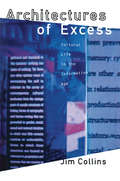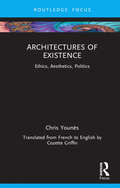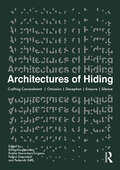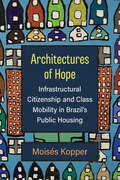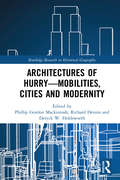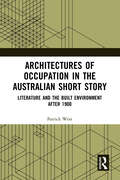- Table View
- List View
Architectures of Excess: Cultural Life in the Information Age
by Jim CollinsFirst Published in 1995. Much of recent theory has characterized life in media-sophisticated societies in terms of a semiotic overload which, allegedly, has had only devastating effects on communication and subjectivity. In Architectures of Excess, Jim Collins argues that, while the rate of technological change has indeed accelerated, so has the rate of absorption. The seemingly endless array of information has generated not chaos but different structures and strategies, which harness that excess by turning it into forms of art and entertainment. Digital sampling in rap music and cyber-punk science fiction are well-known examples of techno-pop textuality, but Collins concentrates on other contemporaneous phenomena that are also envisioning new cultural landscapes by accessing that array--hyper-self-reflexivity in mall movies, best sellers, and prime-time television; the deconstructive vs. new-classical debate in architecture; the emergence of the "New Black Aesthetic;" the development of retro-modernism in interior design and the fashion industries. The analyses of these disparate, discontinous attempts to develop a meaningful sense of location, in an historical as well as a spatial sense, address a cluster of interconnected questions: How is the array of information being "domesticated?" How has appropriationism evolved from the Pop-Art of the sixties to the sampling of the nineties? How has the relationship between tradition, innovation, and evaluation been altered? Architectures of Excess investigates how these phenomena reflect change in taste and subjectivity, considering how we must account for both, pedagogically.
Architectures of Existence: Ethics, Aesthetics, Politics
by Chris YounèsArchitectures of Existence proposes that philosophical thinking (ecosophical thinking) can inform the way we engage with our world and its inhabitants, as architects, designers and planners, but also as individuals, as people, and as a society. In Art et existence, Maldiney states: "For us, to inhabit is to exist". This book aims to unfold, extend, articulate and thicken this postulate by interweaving architecture, city, landscape, literature and philosophy. It takes up the synergistic lines of long-term research carried out from an ecosophical perspective. Such an attitude explores an art of existing in multiplicity, singularity and openness, manifesting the critical dimension through a reinterpretation of the knotting of the trajectories of time, humanity and its becoming. Insisting on what is between things and beings as well as on what is happening, regenerating, recycling, reviving, saving, diversifying, sparing, recreating, meditating: and so caring. These are all eco-rhythms of a different type between human and non-human, to consider ourselves in the world. In an era of uncertainty and climate threats, this book develops the margins of possibility offered by the subject of architecture. This book will be of interest to researchers and students of architecture, urban planning and philosophy.
Architectures of Existence: Ethics, Aesthetics, Politics
by Chris YounèsArchitectures of Existence proposes that philosophical thinking (ecosophical thinking) can inform the way we engage with our world and its inhabitants, as architects, designers and planners, but also as individuals, as people, and as a society. In Art et existence, Maldiney states: "For us, to inhabit is to exist". This book aims to unfold, extend, articulate and thicken this postulate by interweaving architecture, city, landscape, literature and philosophy. It takes up the synergistic lines of long-term research carried out from an ecosophical perspective. Such an attitude explores an art of existing in multiplicity, singularity and openness, manifesting the critical dimension through a reinterpretation of the knotting of the trajectories of time, humanity and its becoming. Insisting on what is between things and beings as well as on what is happening, regenerating, recycling, reviving, saving, diversifying, sparing, recreating, meditating: and so caring. These are all eco-rhythms of a different type between human and non-human, to consider ourselves in the world. In an era of uncertainty and climate threats, this book develops the margins of possibility offered by the subject of architecture. This book will be of interest to researchers and students of architecture, urban planning and philosophy.
Architectures of Festival in Early Modern Europe: Fashioning and Re-fashioning Urban and Courtly Space (European Festival Studies: 1450-1700)
by J. R. Mulryne Krista De Jonge Pieter Martens R. L. M. MorrisThis fourth volume in the European Festival Studies, 1450–1700 series breaks with precedent in stemming from a joint conference (Venice, 2013) between the Society for European Festivals Research and the PALATIUM project supported by the European Science Foundation. The volume draws on up-to-date research by a Europe-wide group of academic scholars and museum and gallery curators to provide a unique, intellectually-stimulating and beautifully-illustrated account of temporary architecture created for festivals of the sixteenth and seventeenth centuries, together with permanent architecture pressed into service for festival occasions across major European locations including Italian, French, Austrian, Scottish and German. Appealing and vigorous in style, the essays look towards classical sources while evoking political and practical circumstances and intellectual concerns – from re-shaping and re-conceptualizing early sixteenth-century Rome, through providing for the well-being and political allegiance of Medici-era Florentines and exploring the teasing aesthetics of performance at Versailles to accommodating players and spectators in seventeenth-century Paris and at royal and ducal events for the Habsburg, French and English crowns. The volume is unique in its field in the diversity of its topics and the range of its scholarship and fascinating in its account of the intellectual and political life of Early Modern Europe.
Architectures of Festival in Early Modern Europe: Fashioning and Re-fashioning Urban and Courtly Space (European Festival Studies: 1450-1700)
by J. R. Mulryne Krista De Jonge Pieter Martens R. L. M. MorrisThis fourth volume in the European Festival Studies, 1450–1700 series breaks with precedent in stemming from a joint conference (Venice, 2013) between the Society for European Festivals Research and the PALATIUM project supported by the European Science Foundation. The volume draws on up-to-date research by a Europe-wide group of academic scholars and museum and gallery curators to provide a unique, intellectually-stimulating and beautifully-illustrated account of temporary architecture created for festivals of the sixteenth and seventeenth centuries, together with permanent architecture pressed into service for festival occasions across major European locations including Italian, French, Austrian, Scottish and German. Appealing and vigorous in style, the essays look towards classical sources while evoking political and practical circumstances and intellectual concerns – from re-shaping and re-conceptualizing early sixteenth-century Rome, through providing for the well-being and political allegiance of Medici-era Florentines and exploring the teasing aesthetics of performance at Versailles to accommodating players and spectators in seventeenth-century Paris and at royal and ducal events for the Habsburg, French and English crowns. The volume is unique in its field in the diversity of its topics and the range of its scholarship and fascinating in its account of the intellectual and political life of Early Modern Europe.
Architectures of Hiding: Crafting Concealment | Omission | Deception | Erasure | Silence
by Rana Abughannam Émélie Desrochers-Turgeon Pallavi Swaranjali Federica GoffiArchitecture manifests as a space of concealment and unconcealment, lethe and alêtheia, enclosure and disclosure, where its making and agency are both hidden and revealed. With an urgency to amplify narratives that are overlooked, silenced and unacknowledged in and by architectural spaces, histories and theories, this book contends the need for a critical study of hiding in the context of architectural processes. It urges the understanding of inherent opportunities, power structures and covert strategies, whether socio-cultural, geo-political, environmental or economic, as they are related to their hidescapes – the constructed landscapes of our built environments participating in the architectures of hiding. Looking at and beyond the intentions and agency that architects possess, architectural spaces lend themselves as apparatuses for various forms of hiding and un(hiding). The examples explored in this book and the creative works presented in the interviews enclosed in the interludes of this publication cover a broad range of geographic and cultural contexts, discursively disclosing hidden aspects of architectural meaning. The book investigates the imaginative intrigue of concealing and revealing in design processes, along with moral responsibilities and ethical dilemmas inherent in crafting concealment through the making and reception of architecture.
Architectures of Hiding: Crafting Concealment | Omission | Deception | Erasure | Silence
Architecture manifests as a space of concealment and unconcealment, lethe and alêtheia, enclosure and disclosure, where its making and agency are both hidden and revealed. With an urgency to amplify narratives that are overlooked, silenced and unacknowledged in and by architectural spaces, histories and theories, this book contends the need for a critical study of hiding in the context of architectural processes. It urges the understanding of inherent opportunities, power structures and covert strategies, whether socio-cultural, geo-political, environmental or economic, as they are related to their hidescapes – the constructed landscapes of our built environments participating in the architectures of hiding. Looking at and beyond the intentions and agency that architects possess, architectural spaces lend themselves as apparatuses for various forms of hiding and un(hiding). The examples explored in this book and the creative works presented in the interviews enclosed in the interludes of this publication cover a broad range of geographic and cultural contexts, discursively disclosing hidden aspects of architectural meaning. The book investigates the imaginative intrigue of concealing and revealing in design processes, along with moral responsibilities and ethical dilemmas inherent in crafting concealment through the making and reception of architecture.
Architectures of Hope: Infrastructural Citizenship and Class Mobility in Brazil's Public Housing
by Moisés KopperArchitectures of Hope examines how communal idealism, electoral politics, and low-income consumer markets made first-time homeownership a reality for millions of low-income Brazilians over the last ten years. Drawing on a five-year-long ethnography among city planners, architects, street-level bureaucrats, politicians, market and bank representatives, community leaders, and past, present, and future beneficiaries, Moisés Kopper tells the story of how a group of grassroots housing activists rose from oblivion to build a model community. He explores the strategies set forth by housing activists as they waited and hoped for—and eventually secured—homeownership through Minha Casa Minha Vida’s public-private infrastructure. By showing how these efforts coalesced in Porto Alegre—Brazil’s once progressive hotspot—he interrogates the value systems and novel arrangements of power and market that underlie the country’s post-neoliberal project of modern and inclusive development. By chronicling the making and remaking of material hope in the aftermath of Minha Casa Minha Vida, Architectures of Hope reopens the future as a powerful venue for ethnographic inquiry and urban development.
Architectures of Hurry—Mobilities, Cities and Modernity (Routledge Research in Historical Geography)
by Phillip Gordon Mackintosh Richard Dennis Deryck W. Holdsworth‘Hurry’ is an intrinsic component of modernity. It exists not only in tandem with modern constructions of mobility, speed, rhythm, and time–space compression, but also with infrastructures, technologies, practices, and emotions associated with the experience of the ‘mobilizing modern’. ‘Hurry’ is not simply speed. It may result in congestion, slowing-down, or inaction in the face of over-stimulus. Speeding-up is often competitive: faster traffic on better roads made it harder for pedestrians to cross, or for horse-drawn vehicles and cyclists to share the carriageway with motorized vehicles. Focusing on the cultural and material manifestations of ‘hurry’, the book’s contributors analyse the complexities, tensions, and contradictions inherent in the impulse to higher rates of circulation in modernizing cities. The collection includes, but also goes beyond, accounts of new forms of mobility (bicycles, buses, underground trains) and infrastructure (street layouts and surfaces, business exchanges, and hotels) to show how modernity’s ‘architectures of hurry’ have been experienced, represented, and practised since the mid nineteenth century. Ten case studies explore different expressions of ‘hurry’ across cities and urban regions in Asia, Europe, and North and South America, and substantial introductory and concluding chapters situate ‘hurry’ in the wider context of modernity and mobility studies and reflect on the future of ‘hurry’ in an ever-accelerating world. This diverse collection will be relevant to researchers, scholars, and practitioners in the fields of planning, cultural and historical geography, urban history, and urban sociology.
Architectures of Hurry—Mobilities, Cities and Modernity (Routledge Research in Historical Geography)
by Phillip Gordon Mackintosh Richard Dennis Deryck W. Holdsworth‘Hurry’ is an intrinsic component of modernity. It exists not only in tandem with modern constructions of mobility, speed, rhythm, and time–space compression, but also with infrastructures, technologies, practices, and emotions associated with the experience of the ‘mobilizing modern’. ‘Hurry’ is not simply speed. It may result in congestion, slowing-down, or inaction in the face of over-stimulus. Speeding-up is often competitive: faster traffic on better roads made it harder for pedestrians to cross, or for horse-drawn vehicles and cyclists to share the carriageway with motorized vehicles. Focusing on the cultural and material manifestations of ‘hurry’, the book’s contributors analyse the complexities, tensions, and contradictions inherent in the impulse to higher rates of circulation in modernizing cities. The collection includes, but also goes beyond, accounts of new forms of mobility (bicycles, buses, underground trains) and infrastructure (street layouts and surfaces, business exchanges, and hotels) to show how modernity’s ‘architectures of hurry’ have been experienced, represented, and practised since the mid nineteenth century. Ten case studies explore different expressions of ‘hurry’ across cities and urban regions in Asia, Europe, and North and South America, and substantial introductory and concluding chapters situate ‘hurry’ in the wider context of modernity and mobility studies and reflect on the future of ‘hurry’ in an ever-accelerating world. This diverse collection will be relevant to researchers, scholars, and practitioners in the fields of planning, cultural and historical geography, urban history, and urban sociology.
Architectures of Inequality: Gender Pay Inequity and Britain’s Finance Sector (Feminist Perspectives on Work and Organization)
by Rachel VerdinAvailable open access digitally under CC-BY-NC-ND licence.The gender pay gap is economically irrational and yet stubbornly persistent. Focusing on the UK finance industry which is known for its gender pay disparity, this book explores the initiatives to fix gendered inequities in the workplace. Rachel Verdin crafts a unique framework, weaving extensive organizational data with women's lived experiences. Interviews uncover gaps in pay transparency, obstacles hindering workplace policies and the factors that are stalling progress for the future. This is an invaluable resource that offers key insights into gender equality and EDI measures shaped by legal regulations as well as corporate-driven initiatives.
Architectures of Inequality: Gender Pay Inequity and Britain’s Finance Sector (Feminist Perspectives on Work and Organization)
by Rachel VerdinAvailable open access digitally under CC-BY-NC-ND licence.The gender pay gap is economically irrational and yet stubbornly persistent. Focusing on the UK finance industry which is known for its gender pay disparity, this book explores the initiatives to fix gendered inequities in the workplace. Rachel Verdin crafts a unique framework, weaving extensive organizational data with women's lived experiences. Interviews uncover gaps in pay transparency, obstacles hindering workplace policies and the factors that are stalling progress for the future. This is an invaluable resource that offers key insights into gender equality and EDI measures shaped by legal regulations as well as corporate-driven initiatives.
Architectures of Justice: Legal Theory and the Idea of Institutional Design (Applied Legal Philosophy)
by Henrik Palmer Olsen Stuart ToddingtonLaw can be seen to consist not only of rules and decisions, but also of a framework of institutions providing a structure that forms the conditions of its workable existence and acceptance. In this book Olsen and Toddington conduct a philosophical exploration and critique of these conditions: what they are and how they shape our understanding of what constitutes a legal system and the role of justice within it.
Architectures of Justice: Legal Theory and the Idea of Institutional Design (Applied Legal Philosophy)
by Henrik Palmer Olsen Stuart ToddingtonLaw can be seen to consist not only of rules and decisions, but also of a framework of institutions providing a structure that forms the conditions of its workable existence and acceptance. In this book Olsen and Toddington conduct a philosophical exploration and critique of these conditions: what they are and how they shape our understanding of what constitutes a legal system and the role of justice within it.
Architectures of Occupation in the Australian Short Story: Literature and the Built Environment after 1900
by Patrick WestPatrick West’s Architectures of Occupation in the Australian Short Story cultivates the potential for literary representations of architectural space to contribute to the development of a contemporary politics of Australian post-colonialism.West argues that the predominance of tropes of place within cultural and critical expressions of Australian post-colonialism should be re-balanced through attention to spatial strategies of anti-colonial power. To elaborate the raw material of such strategies, West develops interdisciplinary close readings of keynote stories within three female-authored, pan-twentieth century, Australian short-story collections: Bush Studies by Barbara Baynton (1902); Kiss on the Lips and Other Stories by Katharine Susannah Prichard (1932); and White Turtle: A Collection of Short Stories by Merlinda Bobis (1999). The capacity of the short-story form to prompt creative and politically germinal engagements with species of space associated with architecture and buildings is underscored. Relatedly, West argues that the recent resurgence of binary thought—on local, national, and international scales—occasions an approach to the short-story collections shaped by binary relationships like a dichotomy of inside and outside. Concluding his argument, West connects the literary and architectural critiques of the story collections to the wicked problem, linked to ongoing colonial violences, of improving Australian Indigenous housing outcomes.Innovative and interdisciplinary, this book will be of interest to scholars and students of Literary, Architectural, and Postcolonial Studies. .
Architectures of Occupation in the Australian Short Story: Literature and the Built Environment after 1900
by Patrick WestPatrick West’s Architectures of Occupation in the Australian Short Story cultivates the potential for literary representations of architectural space to contribute to the development of a contemporary politics of Australian post-colonialism.West argues that the predominance of tropes of place within cultural and critical expressions of Australian post-colonialism should be re-balanced through attention to spatial strategies of anti-colonial power. To elaborate the raw material of such strategies, West develops interdisciplinary close readings of keynote stories within three female-authored, pan-twentieth century, Australian short-story collections: Bush Studies by Barbara Baynton (1902); Kiss on the Lips and Other Stories by Katharine Susannah Prichard (1932); and White Turtle: A Collection of Short Stories by Merlinda Bobis (1999). The capacity of the short-story form to prompt creative and politically germinal engagements with species of space associated with architecture and buildings is underscored. Relatedly, West argues that the recent resurgence of binary thought—on local, national, and international scales—occasions an approach to the short-story collections shaped by binary relationships like a dichotomy of inside and outside. Concluding his argument, West connects the literary and architectural critiques of the story collections to the wicked problem, linked to ongoing colonial violences, of improving Australian Indigenous housing outcomes.Innovative and interdisciplinary, this book will be of interest to scholars and students of Literary, Architectural, and Postcolonial Studies. .
Architectures of Refusal (Architectural Design)
by Jill Stoner Ozayr SaloojeeGuest-edited by Jill Stoner and Ozayr Saloojee Over the past decade, and in a more concentrated form over the past two years, there has been increasing recognition of architecture’s systemic complicity in constructing and upholding hierarchies of race and class, and privileging colonial paradigms that perpetuate spatial and economic inequity. This AD issue reveals how designers, practitioners, scholars and architects are participating in dismantling the major canons of Western architecture. The work is both literal and figural: taking buildings apart and reconstituting them, and challenging mythologies that include drawing-as-analogue, building-as object, architect-as-hero and nature-as-other. Architecture has both potential and responsibility for political agency in the public realm. The contributions to this issue foreground emancipatory spatial ideas and practices from around the world, demonstrating that refusal is no longer just absence and denial, but a constructive mode of resistance and action that needs to be approached through subversive urban works, design pedagogy and alliances across multiple disciplines. Contributors: Piper Bernbaum, Carwil Bjork-James, Thiresh Govender, Lucia Jalón Oyarzun, Jennifer Newsom and Tom Carruthers, Cong Chi Nguyen, Quilian Riano, Hannah Le Roux, Alberto de Salvatierra, Cathy Smith, Chat Travieso, and Ilze Wolff.
Architectures of Refusal (Architectural Design)
by Jill Stoner Ozayr SaloojeeGuest-edited by Jill Stoner and Ozayr Saloojee Over the past decade, and in a more concentrated form over the past two years, there has been increasing recognition of architecture’s systemic complicity in constructing and upholding hierarchies of race and class, and privileging colonial paradigms that perpetuate spatial and economic inequity. This AD issue reveals how designers, practitioners, scholars and architects are participating in dismantling the major canons of Western architecture. The work is both literal and figural: taking buildings apart and reconstituting them, and challenging mythologies that include drawing-as-analogue, building-as object, architect-as-hero and nature-as-other. Architecture has both potential and responsibility for political agency in the public realm. The contributions to this issue foreground emancipatory spatial ideas and practices from around the world, demonstrating that refusal is no longer just absence and denial, but a constructive mode of resistance and action that needs to be approached through subversive urban works, design pedagogy and alliances across multiple disciplines. Contributors: Piper Bernbaum, Carwil Bjork-James, Thiresh Govender, Lucia Jalón Oyarzun, Jennifer Newsom and Tom Carruthers, Cong Chi Nguyen, Quilian Riano, Hannah Le Roux, Alberto de Salvatierra, Cathy Smith, Chat Travieso, and Ilze Wolff.
Architectures of Small-Cell Networks and Interference Management (SpringerBriefs in Computer Science)
by Duy Trong Ngo Tho Le-NgocThis Springer Brief presents the architectures of small-cell networks and recent advances in interference management. The key challenges and values of small cells are first introduced, followed by the reviews of various small-cell architectures and interference management techniques in both heterogeneous CDMA and heterogeneous OFDMA small-cell networks. New adaptive power control and dynamic spectrum access techniques are discussed to promote a harmonized coexistence of diverse network entities in both 3G and 4G small-cell networks. Analytically devised from optimization and game theories, autonomous solutions are shown to effectively manage the intra-tier and cross-tier interferences in small cells. Informative and practical, this Springer Brief is designed for researchers and professionals working in networking and resource management. The content is also valuable for advanced-level students interested in network communications and power allocation.
Architectures of survival: Air war and urbanism in Britain, 1935–52
by Adam PageArchitectures of survival is an original and innovative work of history that investigates the relationship between air war and urbanism in modern Britain. It asks how the development of airpower and the targeting of cities influenced perceptions of urban spaces and visions of urban futures from the interwar period into the Cold War, highlighting the importance of war and the anticipation of war in modern urban history. Airpower created a permanent threat to cities and civilians, and this book considers how architects, planners and government officials reframed bombing as an ongoing urban problem, rather than one contingent to a particular conflict. It draws on archival material from local and national government, architectural and town planning journals and cultural texts, to demonstrate how cities were recast as targets, and planning for defence and planning for development became increasingly entangled.
Architectures of survival: Air war and urbanism in Britain, 1935–52
by Adam PageArchitectures of survival is an original and innovative work of history that investigates the relationship between air war and urbanism in modern Britain. It asks how the development of airpower and the targeting of cities influenced perceptions of urban spaces and visions of urban futures from the interwar period into the Cold War, highlighting the importance of war and the anticipation of war in modern urban history. Airpower created a permanent threat to cities and civilians, and this book considers how architects, planners and government officials reframed bombing as an ongoing urban problem, rather than one contingent to a particular conflict. It draws on archival material from local and national government, architectural and town planning journals and cultural texts, to demonstrate how cities were recast as targets, and planning for defence and planning for development became increasingly entangled.
Architectures of Transversality: Paul Klee, Louis Kahn and the Persian Imagination (Routledge Research in Architecture)
by Shima MohajeriArchitectures of Transversality investigates the relationship between modernity, space, power, and culture in Iran. Focusing on Paul Klee’s Persian-inspired miniature series and Louis Kahn’s unbuilt blueprint for a democratic public space in Tehran, it traces the architectonics of the present as a way of moving beyond universalist and nationalist accounts of modernism. Transversality is a form of spatial production and practice that addresses the three important questions of the self, objects, and power. Using Deleuzian and Heideggerian theory, the book introduces the practices of Klee and Kahn as transversal spatial responses to the dialectical tension between existential and political territories and, in doing so, situates the history of the silent, unrepresented and the unbuilt – constructed from the works of Klee and Kahn – as a possible solution to the crisis of modernity and identity-based politics in Iran.
Architectures of Transversality: Paul Klee, Louis Kahn and the Persian Imagination (Routledge Research in Architecture)
by Shima MohajeriArchitectures of Transversality investigates the relationship between modernity, space, power, and culture in Iran. Focusing on Paul Klee’s Persian-inspired miniature series and Louis Kahn’s unbuilt blueprint for a democratic public space in Tehran, it traces the architectonics of the present as a way of moving beyond universalist and nationalist accounts of modernism. Transversality is a form of spatial production and practice that addresses the three important questions of the self, objects, and power. Using Deleuzian and Heideggerian theory, the book introduces the practices of Klee and Kahn as transversal spatial responses to the dialectical tension between existential and political territories and, in doing so, situates the history of the silent, unrepresented and the unbuilt – constructed from the works of Klee and Kahn – as a possible solution to the crisis of modernity and identity-based politics in Iran.
Architecture's Pretexts: Spaces of Translation
by Aarati KanekarThe aim of this book is to expose readers to architecture’s pretexts that include literary narratives, film, theatre, painting, music, and ritual, as a bridge between diverse intellectual territories and architecture. It introduces a selection of seminal modern and contemporary architectural projects, their situation within the built environment, and their intellectual and formal situation/context as pretexts and design paradigms. Connections between diverse bodies of information will be cultivated along with the ability to posit consequential relationships for the production of architecture. Architecture’s Pretexts seeks to cultivate a vision for architecture that sponsors operative links between the discipline of architecture and those outside of architecture. Exploring the works of various architects including Guiseppe Terragni, Peter Eisenman, Peter Zumthor, Perry Kulper and Smout Allen, and Rem Koolhaas, this book provides the framework to understanding architecture through the lens of art. Key concepts discussed are: allegories, diagrams, form, material, montage, movement, musical ratios, narrative sequence and representation. A valuable tool, with over 75 black and white illustrations, for students and professionals interested in interdisciplinary methods of design thinking.
Architecture's Pretexts: Spaces of Translation
by Aarati KanekarThe aim of this book is to expose readers to architecture’s pretexts that include literary narratives, film, theatre, painting, music, and ritual, as a bridge between diverse intellectual territories and architecture. It introduces a selection of seminal modern and contemporary architectural projects, their situation within the built environment, and their intellectual and formal situation/context as pretexts and design paradigms. Connections between diverse bodies of information will be cultivated along with the ability to posit consequential relationships for the production of architecture. Architecture’s Pretexts seeks to cultivate a vision for architecture that sponsors operative links between the discipline of architecture and those outside of architecture. Exploring the works of various architects including Guiseppe Terragni, Peter Eisenman, Peter Zumthor, Perry Kulper and Smout Allen, and Rem Koolhaas, this book provides the framework to understanding architecture through the lens of art. Key concepts discussed are: allegories, diagrams, form, material, montage, movement, musical ratios, narrative sequence and representation. A valuable tool, with over 75 black and white illustrations, for students and professionals interested in interdisciplinary methods of design thinking.
